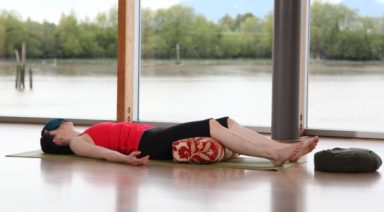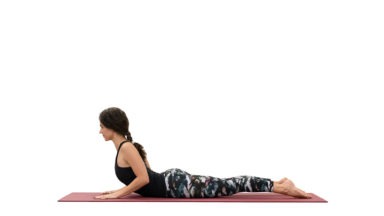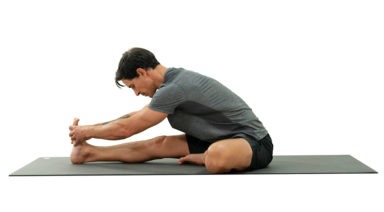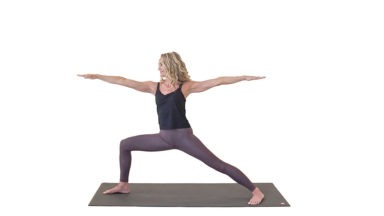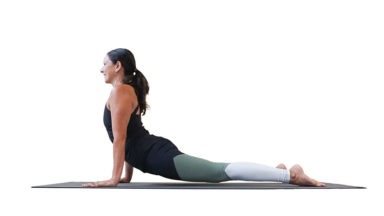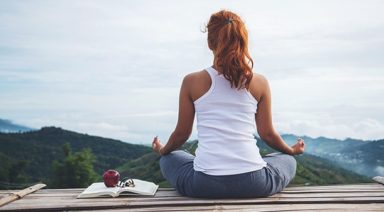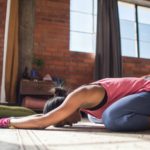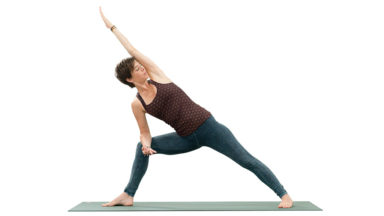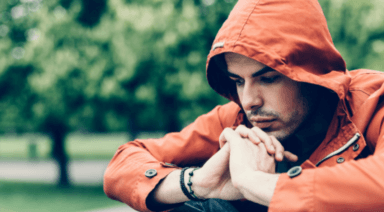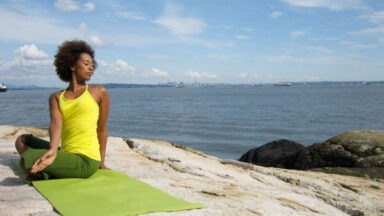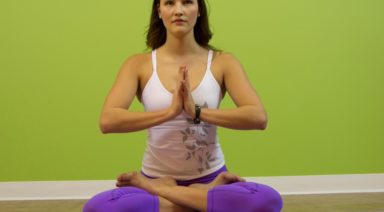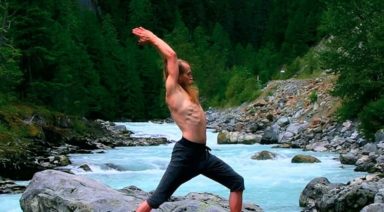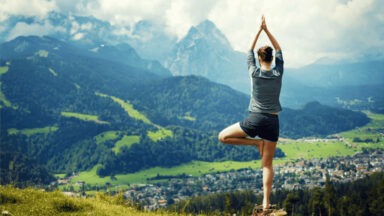What is Restorative Yoga?
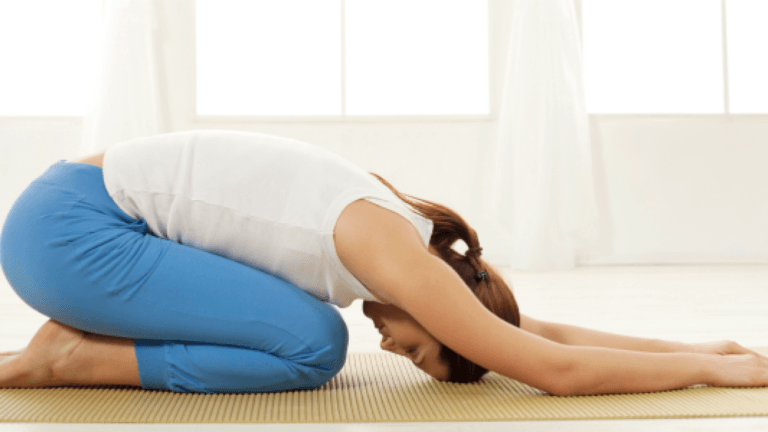
About the same time Staples office supply store debuted their “Easy Button” in 2005, I unexpectedly discovered an easy button on my yoga mat.
If you haven’t seen the Staples commercial or you missed their massive Superbowl ad campaign, let me describe it to you: In the TV commercial, a new father is trying to change his twin infant’s diapers, a child in school is stuck unable to answer a teacher’s question and a cowboy is losing control of a bucking bronco. In the midst of all these scenarios, a bright red, round “Easy” Button appears. All the user has to do is hit the button and all their problems are instantly solved. The commercial closes with the announcer saying “Wouldn’t it be nice if there was an Easy Button for your life? Well now there’s one for your business.”
You might not be wrestling a bucking bronco, but who among us hasn’t found ourselves in situations where we wish a fairy godmother or a big fat happy Easy Button would magically appear and fix all our problems?
In the start of 2005, I’d been practicing yoga for over 5 years.
In fact I’m not quite sure you could call it ‘practice’- I did yoga back then about as regularly as I watered my sad looking cactus plant.
But I was fond of trying out different yoga studios, a habit I thought of as “taking yoga field trips.”
One cold January day I sauntered into a yoga studio in Colorado Springs, prepared for a heated power yoga class. But ten minutes into the class, we were still reclined on rolled up blankets, and I was annoyed as hell that we weren’t sweating our asses off. I was expecting to be moving rapidly through postures, getting some yoga done. My obvious irritation didn’t escape the steady gaze of the instructor. As she guided us into another restorative pose her eyes met mine and she said, “For those of you who are new, you may be wondering, what is restorative yoga?”
Introducing Sammavritti
My urge to twiddle my thumbs and tap my toes began to subside as we were guided to silently count our inhales to a count of 4 or 6, and match that same silent number on the exhale. This practice is called Samavritti, the Sanskrit word that translates to mean equal fluctuations. This simple act of using my mind to connect and direct my breath created a calm sensation unlike any I’d ever experienced. Samavritti quickly became my big red “Easy Button” both on and off the mat.
Credit for developing restorative yoga poses goes to B.K.S. Iyengar, author of Light on Yoga, considered one of the yogic bibles and required reading for virtually every Yoga Teacher Training.
Iyengar creatively explored ways to utilize blankets, yoga blocks, chairs, and bolsters to aid people’s recovery from injuries and ailments.
His early days of nearly eight decades of teaching experience showed him how students overexerting in a yoga pose can cause pain or injury. His path to utilizing support and modifying the shape and length of time held in yoga poses as tools to reduce stress and restore health became the foundation of what we now call restorative yoga. He noted the tremendous benefits of restorative yoga on the thousands of students he worked with. B.K.S. Iyengar debunked the common misperception that restorative yoga is for lazy folk, saying, “Relaxation doesn’t mean yoga is a soft option. It’s a disciplined subject – a casual attempt only gains casual results.”
Benefits of Restorative Yoga
For those with more faith in science than in magic, we can look to our neurological and hormonal systems for the effects of living over stimulated and stressful lifestyles. When stress registers in the mind, it responds by giving a shout out to the adrenal glands, located above the kidneys. The adrenals react by secreting adrenaline and noradrenaline hormones. These are the hormonal weaponry and aircraft that prepare the autonomic nervous system as the body prepares for fight or flight response to stressful stimuli.
Like an overactive army, adrenal glands continue to pump stress hormones for hours after you swerved to miss the teenage texter who suddenly drifted into your lane. And they’ll continue for a long time, months after you’ve been served with divorce papers, weeks after you recover from a bad fall. The point is, as Judith Lasater Ph.D. simply states, “stress can make you sick.” Dr. Lasater’s research is often referenced in detailing the benefits of restorative yoga. Here are five ways restorative yoga can become your Easy Button:
Use Restorative Yoga to Support You in the Midst of Your Stressful Life
When we feel supported, we are more inclined to relax and release long held tension. You know that ‘Ahhh’ sound you sigh when your ass hits the sofa on Friday evening after an arduous week? Yeah, that one. Restorative yoga can give you that feeling even if it’s Tuesday.
Restorative Yoga can benefit and strengthen your spine
Well-balanced restorative sequences tend to the health of our spines through gentle movements of forward bending, back bending and twists. There is a Latin saying, “Mens sane in corpore sana” meaning: A healthy mind in a healthy body. The same is true of a healthy spine lending to a healthy mind. Anyone who’s experienced pain or spinal injury knows all too well that pain can take up residence in the mind.
Restorative Yoga can Change Your Relationship to Gravity
The majority of our waking hours are spent standing and sitting; postures which cause the accumulation of blood and lymph in our lower bodies. By elevating the legs in up the wall pose for example, inflammation is alleviated. In addition the function of the heart is enhanced in inverted restorative postures. Perhaps the yogic equivalent of flipping a U-Turn, research has shown that inverted poses adjust hormone levels, blood pressure and brain activity.
Restorative Yoga Stimulates and Soothes Your Internal Organs
Just think of it as a vacation to Fiji for your innards. The combination of forward bending mildly constricts the abdomen, and when followed by reopening the abdominals with a backbend, serves in the detoxifying movement of blood and exchange of oxygen. Gentle twists stimulate the digestive tract, tending to the absorption of nutrients on the right side, the ascending colon; aiding in the process of elimination on the left side, the descending colon, and laterally with the transverse colon.
Restorative Yoga Can Balance Your Energy
The Gravity Guru, Sir Isaac Newton, is credited with the discovery that, “what comes up, must come down”. The practices of restorative yga rest on this knowledge, balancing out the upward flow of energy, called ‘Prana’, with the downward flow of energy, called ‘Apana’. Pranic energy moves from above the diaphragm to regulate heart rate and respiration. The Apanic energy moves from below the diaphragm to direct the organs in the abdominal region. James Brown also held this yogic truth as depicted in his lyrics, “you gotta get up to get down”.
Restorative Yoga as Medicine
When I first saw the Easy Button commercial I didn’t think it related to my life at all. After all, I’m not diapering twins or performing surgery or taming wild horses. But the truth is that stress, anxiety and worry are common experiences for most of us on a daily basis. The American Institute of Stress (now there’s a bummer of a business name!) says that 3 out of 4 of all doctor’s visits are for stress-related ailments and that stress is the basic cause of up to 60% of all human ailments and disease. Stress actually shrinks the grey matter in your brain and costs our society over $300 billion every year in health costs and loss of productivity.
Every individual experiences it differently, but for yoga practitioners the beneficial practices of restorative yoga can be serious medicine in the fight against stress and worry.
So next time your boss decides to cancel your vacation or your toddler flushes the Legos or your teenager swipes your credit card and heads to the mall, hit the Easy Button and give your body and mind a break. You will be roping those wild horses again in no time.
Yoga for Insomnia

Not getting enough sleep or waking up in the middle of the night is the worst, except maybe not being able to get to sleep in the first place. Tossing and turning when all you want to do is catch some much needed zzzzzzzs is miserable. Lack of sleep can also increase risk of illness and decrease productivity. Roughly 60 million Americans are affected by chronic sleeplessness; women and people over the age of 65 are disproportionately impacted by this disorder.
There are a million reasons sleep can be elusive. Perhaps you have too much on your mind or maybe you are already anxious about everything you need to accomplish the next day. You also could be dealing with a more serious condition like insomnia. For a chronic problem, see your physician, but there are also some simple things you can do to combat occasional sleeplessness.
Insomnia runs in my family. If I have learned anything from my family members, it is that sleeplessness is more about getting your mind right and adjusting your daily habits and less about knocking yourself out with medication.
Why Yoga for Sleep?
According to Science Daily, “sometimes called the rest and digest system, the parasympathetic system conserves energy as it slows the heart rate, increases intestinal and gland activity, and relaxes sphincter muscles in the gastrointestinal tract”. The parasympathetic nervous system (PNS) is responsible for involuntary movement, which means you don’t always know when it is working and when it is struggling to keep up or is blocked. The PNS controls crying, salivation, urination, and digestion and works when it is at rest. Insomnia can dramatically decrease your PNS’s ability to function at full capacity.
Fortunately, the benefits of yoga, such as lowered stress, reduced blood pressure and better circulation, increase the activation of the PNS leading to better mental relaxation and better sleep.
One technique you may consider for preventing those sleepless nights is a regular yoga practice, especially gentle yoga in the evening. This is probably different from the yoga you practice in a studio. It is similar to restorative yoga in that it concentrates on low tension positions. Think of it more as stretching with a focus on your breath and calming your mind. If you find a few positions you really like, add them into your bedtime routine.
Relaxation is crucial to combatting insomnia. By focusing on your body, you are less likely to let your brain takeover and more likely to put aside the daily stressors to prepare for bedtime. In addition, yoga helps slow your breath, which should leave you feeling more calm. A few poses that are ideal for this include:
Child’s Pose – Balasana
Benefits
A common resting pose to regain control of your breath after a round of more challenging postures or movements, this position has virtues of its own when performed in isolation. It opens your hips, allows for better circulation, and most importantly, helps relax your mind.
Give it a Try
Begin in tabletop pose with your hands and knees on your mat. Your hands should be firmly below your shoulders and your knees below your hips. Next, sit back on your heels and spread your knees to the edges of your mat. While gently lowering your forehead to your mat, reach your hands at the top of your mat. Stay this way for several minutes. Focus on your breath. Breath in and out slowly. Concentrate on every inhale and exhale.
After a few minutes, spread you knees wider, which should sink your head lower into your mat. Stretch your arms farther up your mat and shift your focus to your fingertips. Fan out your fingers and press them into the mat. Remain here for several more minutes, then slowly lift your head and open your eyes. If that felt good, repeat two to three times before climbing into bed.
Supine Spinal Twist – Supta Matsyendrasana
Benefits
Opens your chest and stretches out your leg muscles. Alleviates pain in your lower back. Persistent back pain can often keep you tossing and turning at night.
Give it a Try
You can do this on a mat, soft carpet, or even in bed. Being by lying down on your back with your arms out to the sides, so that your body is in a “T” shape. As you inhale, lift your heels off the ground. Exhale and lower your heels back down, turning your knees to the left side of your body. Keep your knees stacked on top of each other.
Continue to focus on your breath, while turning your head to the right. Allow your right shoulder to press deeper into the mat maintaining the twist through the upper spine. Gently place one hand on top of your knees to deepen the stretch. Hold for at least 20 seconds, but feel free to stay in this position as long as you like, then repeat the stretch on the other side.
Legs Up The Wall Pose – Viparita Karani
Benefits
Lessens menstrual cramps and headaches, relives lower back pain and stress, and reduces the weight off the body which will help ease you into sleep.
Give it a Try
This position requires some set-up. First, grab two large blankets and a small towel/eye mask to put over your eyes. Fold one blanket in half and place it on top of your mat. Both your mat and the folded blanket should be along a wall so that your entire back will fit on top. Then, fold a second blanket thicker than the first and place to the side.
Lie on top of the first blanket with your seat against the wall and legs going up the wall. Place the folded blanket under your seat so that it elevates your seat and keeps your back on the ground. Your body should be in an “L” shape with the floor and the wall, if there is any space, gently shimmy your body forward so that you are making full contact with the wall.
Once your body is positioned, place the small towel/eye mask over your eyes and rest your arms along your sides. Allow your mind to empty. Focus on your breath and enjoy the sensations in your legs, as you stay in this position for about five minutes.
Cat-Cows – Chakravakasana
Benefits
This is a great position before bedtime if you spend most of your day sitting. Quickly builds heat and sheds extra energy to help you ease into sleep.
Give it a Try
Begin in tabletop position (same as Child’s Pose). Make sure your wrists are right under your shoulders and knees under your hips. Let go of any tension in your back and allow your spine to retain a neutral position.
Curl your toes under and tilt your pelvis back. Your seat should be raised, your back in a “U” shape and your gauze should be forward and slightly up towards the ceiling. You are now in the cow pose. Hold for a long exhale.
To transition into the cat pose, uncurl your feet so that your soles are facing up. Tip your pelvis forward and tuck your tailbone. Move your gauze down to your mat, allowing your head to follow and your spine to form an inverted “U.” Pull your navel into your spine and hold. Hold for a long inhale.
Inhale and exhale for several rounds. Remember to form a cat pose on inhale and a cow pose to exhale. Do this for at least three minutes, then rest in child’s pose. If you are still feeling restless, do two or three more rounds just like the first.
Happy Baby – Ananda Balasana
Benefits
Lubricates your joints, calms the mind, and releases tensions in the body.
Give it a Try
This is an easy, fun one. First, lie on your back on top of your mat. Hug your knees into your chest. Take 10-15 seconds in the pose to warm-up your body. Then, grab the soles of your feet (or ankles if grabbing your feet is impossible or uncomfortable). Using your hands, pull your legs apart and to the sides and hold the stretch for another 10-15 seconds. If it feels good, gently rock from left to right. Allow your head and shoulders to press deeper into the mat. Lastly, let go of your feet and return to hugging your knees. Repeat this exercise as many times as desired.
Pigeon Pose – Kapotasana
Benefits
Relieves tension in the chest and shoulders. Also, helps to relieve stress and anxiety.
Give it a Try
Begin the same way as Child’s Pose or Cat-Cows exercise – in tabletop pose with your hands and knees on your mat. Bring your right knee as far forward as it will go comfortably and slide slightly to the right of your body. Your toes should naturally tuck under your seat.
Shifting your focus to your left leg, slide your left leg as far back as possible. Make sure the soles of your feet face upwards. Place your hands on either side of your legs.
Then on exhale, extend your arms forward to the top of your mat, lay your torso down over your right leg, and lower your forehead onto your mat. Stay here for ten breaths. Then, deepen your stretch as much as possible by sinking into your hips and stay for another ten breaths.
Next Steps
You don’t have to resort to expensive, potential harmful prescription drugs to get a good night’s sleep. In addition to the pre-bedtime yoga positions suggested above, there are Ayurvedic sleep remedies and other natural techniques you can use to help you drift off to sleep and stay asleep, including:
- Routine. Routine. Routine. I can’t stress this enough. The simple act of doing your bedtime rituals in the same order can help remind your brain it is time to sleep. Make a list of what you typically do before bed and stick to it as much as possible.
- Your Bedroom. Is your sleeping space conducive to sleeping? If there are any lingering signs of work, get it out of there! Your bedroom should be exclusively used for two things. (I’ll let you read in between the lines on that one.)
- Relaxing Music can help you wind down. You want music that doesn’t have lyrics and won’t keep your mind racing.
- Scents can change your mood. I swear by an aromatherapy scent that I use before bedtime or anytime I am stressed. I have it in lotion, candles, and pillow spray.
- Write it down. Keeping a pen and paper on your nightstand can be an easy way to add things to your to-do and get them off your mind.
- More Yoga. There are other types of yoga that can be beneficial, including Kundalini Yoga and Yoga Nidra.
Yoga Nidra is one of my favorite things in the world. In fact, I treat myself to it for my birthday every year. It is essentially a yoga nap which will have you drifting off to sleep in no time.






